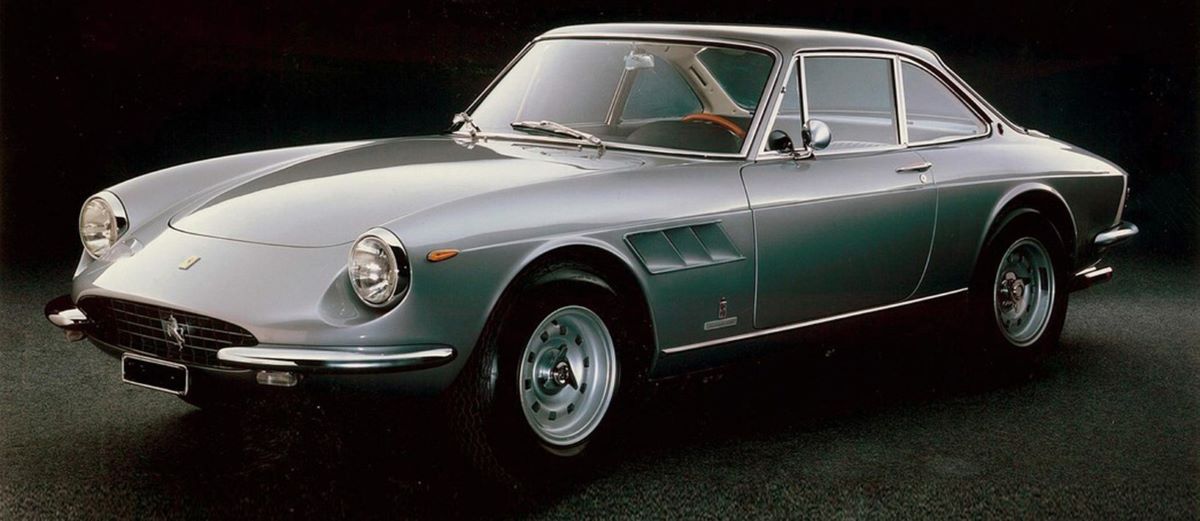
The 330 GTC Coupé was unveiled at the 1966 Geneva Salon, as an additional model to the Ferrari production car range. It was designed by Pininfarina, and was assembled at their works in Turin, before being delivered fully trimmed to Ferrari for fitment of mechanical components.
The body forward of the windscreen was very similar in style to the Ferrari 500 Superfast model. The 330 GTC was unusual for a Ferrari in that it had a model badge on the boot lid, proclaiming ‘330’. Prior to this only a very few cars had any model identity on them, and those that did were normally ‘Speciales’. The nose featured a slim, projecting ovoid radiator grille, headlights in shallow recesses in the forward face of the wings, which had triple louvre engine bay exhaust outlets in their sides, bounded by a slim bright trim strip on three sides. This was married to a tail section that was first used on the earlier 275 GTS, to produce a harmonious, light and elegant design that featured slim quarter bumpers at each corner. The 330 GTC had a cabin with very slim pillars, which gave an airy feel to the interior and excellent visibility. The design was specific to this model, and was carried over to the later 365 GTC.
The body was mounted on a 2,400 mm wheel base tubular steel chassis with factory reference number 592, and all were numbered in the odd chassis number road car sequence. The principal layout was very similar to that of the concurrently produced 275 GTB models, as the mechanical layout was virtually identical. The standard road wheels were 7L x 14 in, fitted with 205 x 14 in tyres, of an elegant and smooth 10-hole alloy design, similar to those used on the sports racing competition Ferrari models of the period, with a knock-off spinner to the Rudge hub (Borrani wire wheels were available as an option). All models in the series were fitted with four wheel Girling disc brakes, with a cable-operated handbrake actuating separate callipers on the rear discs.
The engine was an enlarged version of that fitted to the 275 GTB, and virtually identical in specification to that used in the late series 330 GT 2+2 models: a single overhead camshaft per bank V12 wet sump unit, with factory type reference 209/66, of 3,967 cc capacity, with a bore and stroke of 77 x 71 mm.
It was fitted with a bank of either three twin choke Weber 40 DCZ/6 or 40 DFI/2 carburettors, with a twin coil and rear of engine-mounted distributor ignition system, to produce a claimed 300 bhp. The only significant changes to the mechanical specification during production were: substitution of twin oil cooler radiators for the original single unit from chassis 09839, plus a modified fuel delivery system and molybdenum-sprayed gearbox with synchromesh rings from chassis 09939. The 330 shared the same transmission and rear suspension layout as the post-April 1966 275 GTB model: two engine mounting points and two transaxle support points, with a rigid torque tube connecting the two to form a solid unit.
The transaxle was a type 592/1369 5-speed unit, with independent coil spring and wishbone rear suspension and Koni shock absorbers. The independent front suspension was by unequal length wishbones with coil springs and Koni hydraulic shock absorbers, whilst the steering was worm and roller without power assistance.
The driver had an elegant, three-spoke wood rim Nardi steering wheel in front of the main shrouded instrument nacelle, which projected from the top of the dash panel, and housed the circular dial rev counter and matching speedometer. A trio of smaller dials held the water temperature, oil temperature and pressure gauges, each with a black face and white script. In the centre of the dash panel was a row of three further small circular gauges: fuel level, clock and ammeter, with a lockable, illuminated glove box on the passenger side.
The instrument nacelle and dash faces had a teak veneer finish, with an upholstered padded roll matching the dash top provided to the lower edge of the dash panel. A centre console, incorporating a row of switchgear, ventilation outlets and radio on the sloping face, ran from the lower edge of the dash face down to the transmission tunnel and then tapered between the seats to the rear bulkhead. In the forward section was the chrome-plated gear lever with black plastic knob, moving in an open gate, with a chrome-lidded ashtray and cigarette lighter alongside it; electric window switches on a sloping face were just behind them.
At the 1967 Brussels Salon, Pininfarina presented a special-bodied example of the 330 GTC, on chassis 09439 (job number 99670), destined for The Princess Liliane De Rethy, of which just four examples were eventually built. The Princess Liliane was no stranger to personalised Ferraris, as the special-bodied 330 GTC was her third, and her husband, King Leopold III of Belgium, was also a good Ferrari client. He owned two bespoke models – both cabriolets: a 342 America (chassis 0234AL) and a 375 MM (chassis 0488AM), equipped with a Plus series engine. The Princess Liliane still owned her 330 GTC ‘Speciale’ up to the time of her death at the age of 85, in June 2002.
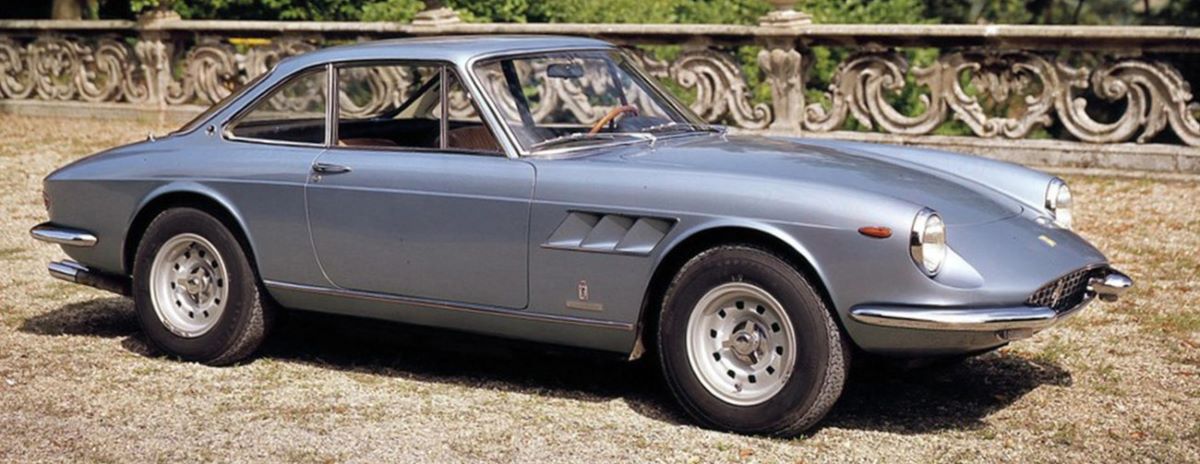
The second example was built on chassis 09653 with Pininfarina job number 99676, and exhibited in March 1967 at the Geneva Salon, destined for Dr Michael de Bakey of Houston, Texas. Number three was chassis 10107, with Pininfarina job number 99686, for Maria Maddalena Da Lisca of Cortina d’Ampezzo in Italy. The final car in the series was chassis 10241, built on Pininfarina job number 99687, for Dr Franco Palma of Rome, Italy. The first two were finished in azzuro 19278M Italver with pelle nera Franzi interiors. The last two were painted in argento 25090A Italver, with chassis 10107 having a pelle nera Franzi interior, and chassis 10241 having a pelle blu Franzi interior.
These cars featured the nose section of the Ferrari 365 California, with a redesigned glass area to the cabin that had a concave, curved rear screen between buttressed sail panels that ran down to a Kamm tail, on which were a pair of triple circular lens tail light assemblies on a rectangular chrome-plated panel, above a full width wrap-around bumper. There were detail differences between individual cars, the most noticeable of these being the engine bay exhaust air arrangement. On chassis 09439 and 09653 this was achieved by two rows of five rectangular slots along the trailing edge of the bonnet. Chassis 10107 and 10241 had small black louvre panels in the rear corners of the bonnet, in the style that would become standard for the then upcoming 365 GTC/S series.
The first three cars in the series were fitted with front quarter bumpers that curved into the grille opening, as on the 365 California, and were fitted with a nudge bar spanning them to protect the elegant nose. The last in the series had quarter bumpers that stopped short of the grille opening, with no nudge bar fitted. At the front of the car, it should be noted that the first two examples were fitted with 365 California-style pop-up driving lights in the upper nose panel, whereas the last two cars lacked these.
There were other 330 GTC models constructed with individual special details. Amongst these was the prototype (chassis 06431), which has erroneously been reported as having been built on a 275 GTS frame (the build sheet indicates a type 592 chassis): it had a special instrument panel, door trim panels and rear luggage shelf. Chassis 08727 had pop-up driving lights in the nose panel, unique exterior trim and a special interior fitted for Battista Pininfarina. The greatest deviation from standard (apart from the four ‘Speciale’ models) was chassis 09571, which had pop-up driving lights in the upper nose panel, covered headlights, a full rear bumper assembly, special door handles and a one-off instrument panel with no speedometer.
In a little over two years, a total of 598 examples were produced in both left and right hand drive form, in the chassis number range 08329 to 11613 (excluding prototypes). The 330 GTC model is considered by many to be amongst the finest cars of this type of the era. Apart from their obvious svelte lines, it offers power with sophistication, plentiful torque, light controls, good luggage capacity, great visibility, and a refined V12 aural soundtrack.
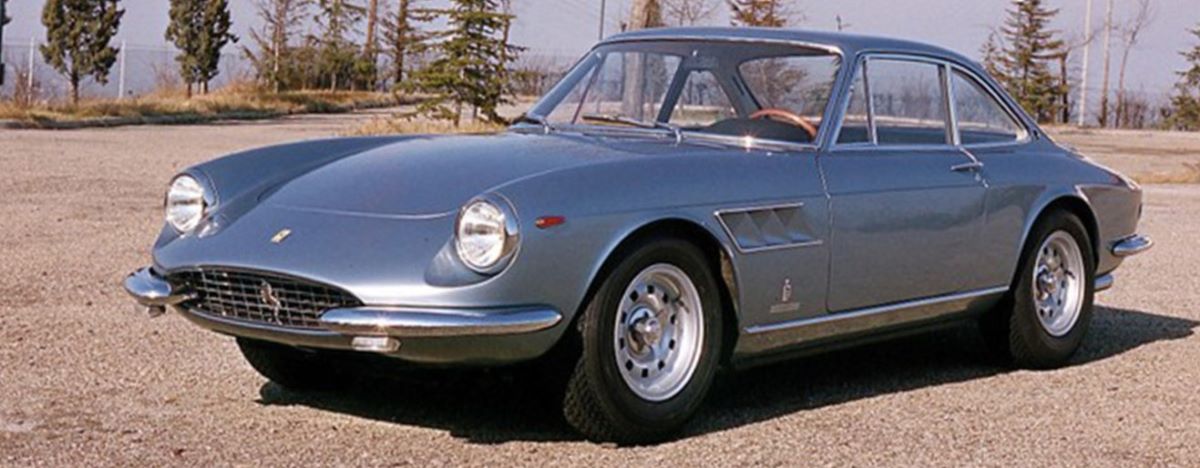
Engine
- Type front, longitudinal 60° V12
- Bore/stroke 77 x 71 mm
- Unitary displacement 330.62 cc
- Total displacement 3967.44 cc
- Compression ratio 8.8 : 1
- Maximum power 221 kW (300 hp) at 7000 rpm
- Power per litre 76 hp/l
- Valve actuation single overhead camshaft per bank, two valves per cylinder
- Fuel feed three Weber 40 DCZ/6 or 40 DFI/2 carburettors
- Ignition single spark plug per cylinder, two coils
- Lubrication wet sump
- Clutch single-plate
Performance
- Top speed 242 km/h
Chassis
- Frame tubular steel
- Front suspension independent, unequal-length wishbones, coil springs over telescopic shock absorbers, anti-roll bar
- Rear suspension independent, unequal-length wishbones, coil springs over telescopic shock absorbers, anti-roll bar
- Brakes discs
- Transmission 5-speed + reverse
- Steering worm and roller
- Fuel tank capacity 90 litres
- Front tyres 205 x 14
- Rear tyres 205 x 14
Bodywork
- Type two-seater coupé
- Length 4470 mm
- Width 1665 mm
- Height 1282 mm
- Wheelbase 2400 mm
- Front track 1401 mm
- Rear track 1417 mm
- Weight 1300 kg (dry)
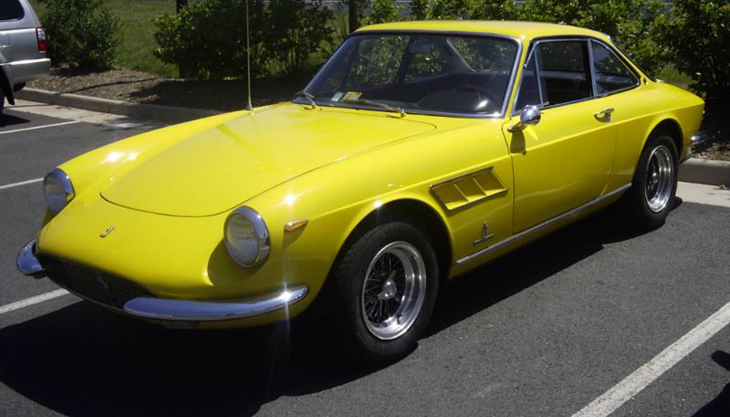

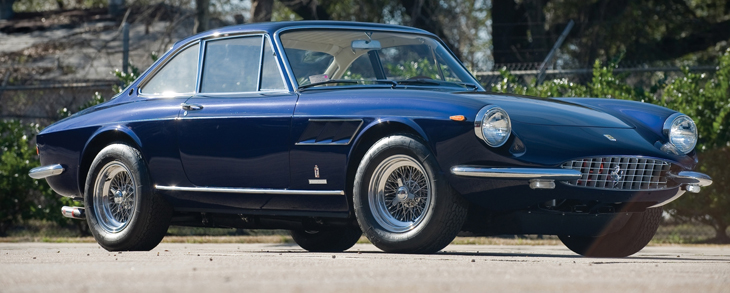

You must be logged in to post a comment.